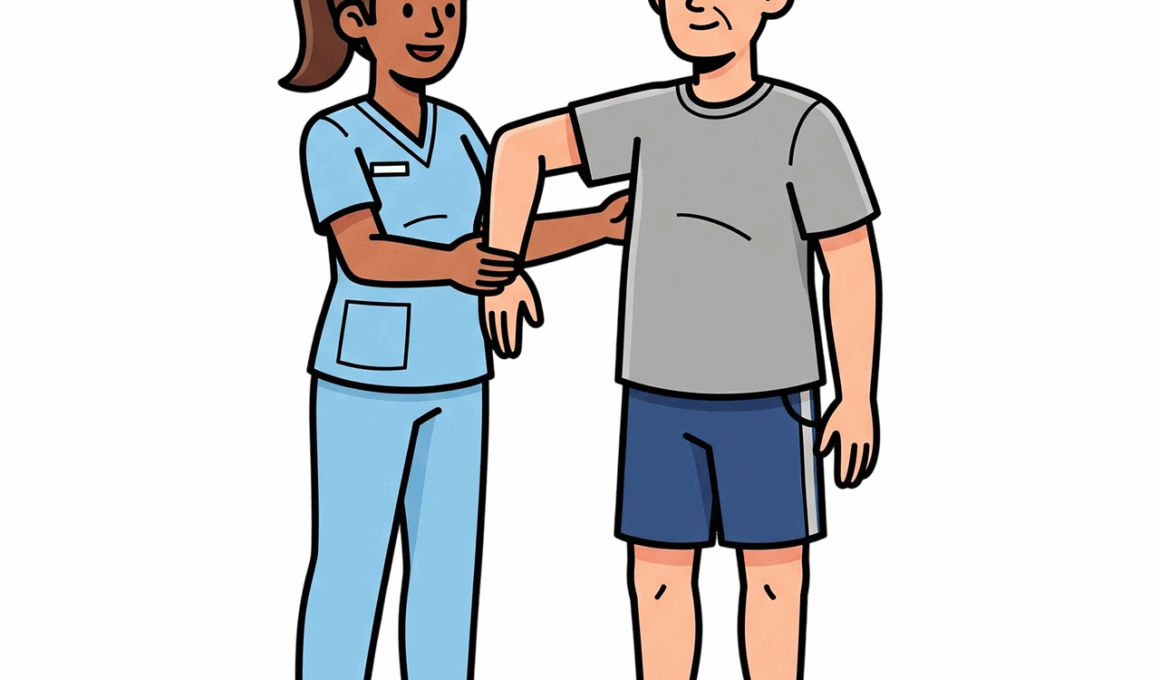Static Balance Training for Rehabilitation After Injury
Balance and coordination are essential components of physical health, especially after an injury. Static balance training plays a significant role in rehabilitation, helping to restore stability and prevent future occurrences. The emphasis on static exercises allows the body to engage core muscles effectively, enhancing feedback from the nervous system during movements. By focusing on maintaining a stable position, individuals can strengthen muscles and improve proprioception. Essential exercises often include standing on one leg or holding specific positions for sustained periods. This training enhances the body’s ability to control movements in various environments, which is crucial post-injury. Consequently, incorporating static balance exercises into a rehabilitation program facilitates progress and encourages patient confidence. Clients should work closely with rehabilitation professionals to establish a suitable routine tailored to their needs. Visualization and mindful practices can also contribute positively to the rehabilitation journey, allowing individuals to mentally prepare for physical challenges. Progress tracking is vital to detect improvements and adjust workout intensity. As rehabilitation continues, adding dynamic movements will support advanced recovery stages while retaining strong foundations built during static training.
The Importance of Static Balance
Static balance is a crucial factor during recovery from injuries, as it allows individuals to regain control over their body movements. This phase of rehabilitation focuses on developing muscle strength and joint stability to minimize the risk of re-injury. Proper static balance helps stabilize various body parts while standing or engaging in seated activities. Functional exercises such as standing on one leg or using balance boards create an environment for individuals to build their strength gradually. Proper implementation of these exercises encourages improvements in coordination and body awareness, which are critical to enhancing overall performance. Additionally, practitioners can modify these balance exercises based on individual injury recovery progress, providing personalized approaches to training. Engaging in structured static balance activities fosters mental focus, allowing rehabilitation clients to concentrate on their movement patterns and body positioning. The psychological aspect of recovery is just as important as the physical; promoting confidence leads to better outcomes. A dedicated approach to training and consistent practice will result in increased stability and functionality, which translates into improved capabilities for daily life activities post-rehabilitation.
Rehabilitation after injury requires a thorough assessment of individual needs and capabilities to create effective static balance training programs. Tailoring these programs allows recovery professionals to meet the unique challenges faced by each patient. As rehabilitation progresses, static balance exercises should evolve to maintain patient engagement and interest. Starting with simple exercises can build confidence and strength, gradually introducing more complex movements as performance improves. Practitioners must establish realistic goals for patients, encouraging them to stay committed and motivated throughout the rehabilitation process. Guided practices and frequent assessments will ensure proper execution and prevent potential setbacks. Patients should be educated about the benefits of these exercises as part of their recovery journey. Moreover, incorporating mobility training techniques is essential to complement static balance training, promoting a holistic approach to recovery. Clients benefit when they understand how their rehabilitation fosters better balance and coordination in all aspects of their life. Given the increasing reliance on technology, balancing static training with everyday movements can prepare individuals for returning to various activities they enjoy while ensuring safety. A comprehensive strategy tailored to individual needs will enhance outcomes significantly.
Incorporating Static Balance Exercises
Incorporating static balance exercises into rehabilitation plans requires creativity and adaptability based on patient feedback. Practitioners should encourage a variety of routines while maintaining correct form to maximize benefits. Effective strategies include gradually increasing duration while ensuring proper alignment and muscle activation. Variability and challenge keep patients engaged, which can enhance their commitment and development. Engaging in diverse training formats such as standing heel-to-toe or using various surfaces like wobble boards stimulates more significant muscle engagement. Physical environments may also be altered to add challenges and promote better adaptations during workouts. Implementing a diverse array of exercises will keep patients motivated and committed to their recovery process. Adding visual or auditory cues can enhance focus and concentration during practices, deepening engagement. Encouragement and support can go a long way in sustaining motivation through rehabilitation. Additionally, integrating family and peer support can help patients share their struggles while celebrating progress milestones. Ultimately, combining personalized strategies fosters a sense of achievement and satisfaction for rehabilitation clients. They should appreciate the relationship between balance and coordination and rebuilding confidence in physical abilities to ensure lasting improvement.
Progressive overload in static balance training is key to achieving significant rehabilitation results. This principle emphasizes gradual increases in exercise difficulty to continuously challenge the body and promote enhancements in coordination. As patients progress, introducing additional challenges helps maintain motivation and encourages self-efficacy. Rehabilitation professionals can utilize different strategies when applying progressive overload. For example, changing the duration of balance holds, adding resistance, or incorporating varying surfaces effectively increases exercise intensity. When progressing through training stages, practitioners should emphasize patients’ body awareness and alignment focus. Emphasizing control and precision during exercises will solidify foundational elements essential for successful rehabilitation outcomes. Ongoing evaluations allow practitioners to provide timely feedback and recommend modifications based on performance. Communication is vital to understanding clients’ concerns and celebrating achievements. Incorporating technology, such as balance assessment apps, can modernize training methods while tracking progress efficiently. Consistent challenge and assessment create a supportive environment, making steady progress more plausible. Continuous improvement promotes the mental and physical resilience necessary for more advanced rehabilitation stages. As patients regain strength and balance, encouraging reintegration into daily activities highlights successful rehabilitation efforts.
The Role of Mindfulness in Balance Training
Mindfulness plays an integral role in enhancing the effectiveness of static balance training during rehabilitation. Practitioners are increasingly recognizing the positive impact of mental awareness techniques for improving physical outcomes. Encouraging patients to focus on their breath and movements fosters a deeper mind-body connection, which enhances awareness during balance activities. Mindfulness may facilitate patients’ ability to maintain concentration while performing movements and holding postures effectively. Integrating mindful practices into routine sessions can promote relaxation, reduce anxiety, and boost overall recovery experiences. Specific mindfulness techniques like visualization enable patients to mentally rehearse effective balance strategies, reinforcing correct movement patterns in a controlled environment. Consequently, growing levels of confidence lead to an enhanced willingness to participate fully in rehabilitation activities. The synergy between physical training and mental emphasis creates a holistic approach that promotes well-rounded recovery. Ultimately, developing an understanding of the mind-body connection plays a vital role in rehabilitation success. Encouraging patients to integrate mindfulness practices into their balance training can foster long-term strategies for safety and confidence. Additionally, promoting self-care and self-awareness offers valuable tools for managing physical challenges in everyday life.
Static balance training provides foundational skills essential for enhancing performance and independence after injury. Completing rehabilitation successfully is not merely about physical recovery; it is also about adapting to new circumstances, regaining independence, and developing new physical competencies. Patients must learn to trust their bodies again, and the right balance exercises can assist in re-establishing that trust. Engaging in balance routines can build a sense of accomplishment, leading to increased motivation throughout the recovery process. Additionally, as individuals progress, their newfound abilities may promote a more active lifestyle, transforming their post-injury outlook. This transformation not only leads to better physical capabilities but can also contribute to improved emotional and mental well-being. Practitioners play a crucial role in providing guidance and support throughout the rehabilitation journey. By fostering a supportive environment, professionals encourage the exploration of new activities and healthy challenges. Individuals empowered through positive feedback and encouragement will likely remain committed to rehabilitation efforts. Ultimately, static balance training is a transformative tool, enabling patients to reclaim their function while fostering resilience and confidence in their abilities.


